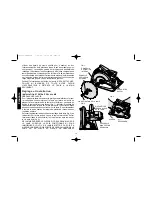
English
2
•
STAY ALERT.
Watch what you are doing. Use common sense. Do
not operate tool when you are tired.
•
CHECK DAMAGED PARTS.
Before further use of the tool, a
guard or other part that is damaged should be carefully checked
to determine that it will operate properly and perform its intended
function. Check for alignment of moving parts, binding of moving
parts, breakage of parts, mounting, and any other conditions that
may affect its operation. A guard or other part that is damaged
should be properly repaired or replaced by an authorized service
center unless otherwise indicated elsewhere in this instruction
manual. Have defective switches replaced by authorized service
center. Do not use tool if switch does not turn it on and off.
Additional Safety Instructions for Circular
Saws
•
CAUTION:
When cutting into walls, floors or wherever live electrical
wires may be encountered, DO NOT TOUCH ANY METAL PARTS
OF THE TOOL! Hold the tool only by insulated grasping surfaces to
prevent electric shock if you cut in the live wire.
•
KEEP GUARDS IN PLACE AND IN WORKING ORDER.
Never
wedge or tie lower guard open. Check operation of lower guard
before each use. Do not use if lower guard does not close briskly
over saw blade.
CAUTION:
If saw is dropped, lower guard may be
bent, restricting full return.
•
KEEP BLADES CLEAN AND SHARP.
Sharp blades minimize
stalling and kickback.
•
DANGER: Keep hands away from cutting area.
Keep hands
away from blades. Do not reach underneath work while blade is
rotating. Do not attempt to remove cut material when blade is
moving.
CAUTION:
Blades coast after turn off.
•
SUPPORT LARGE PANELS.
Large panels must be supported as
shown in Figure 16 to minimize the risk of blade pinching and
kickback. When cutting operation requires the resting of the saw on
the work piece, the saw shall be rested on the larger portion and the
smaller piece cut off.
•
USE RIP FENCE.
Always use a rip fence or straight edge guide
when ripping.
•
GUARD AGAINST KICKBACK.
Kickback occurs when the saw
stalls rapidly and is driven back towards the operator. Release
switch immediately if blade binds or saw stalls. Keep blades sharp.
Support large panels as shown in Figure 16. Use fence or straight
edge guide when ripping. Don’f force tool. Stay alert-exercise
control. Don’t remove saw from work during a cut while the blade is
moving.
•
LOWER GUARD.
Raise lower guard with the retracting handle.
•
ADJUSTMENTS.
Before cutting be sure depth and bevel
adjustments are tight.
•
USE ONLY CORRECT BLADES IN MOUNTING.
Do not use
blades with incorrect size holes. Never use defective or incorrect
blade washers or bolts.
•
AVOID CUTTING NAILS.
Inspect for and remove all nails from
lumber before cutting.
WARNING:
Some dust created by power sanding, sawing, grinding,
drilling, and other construction activities contains chemicals known to
cause cancer, birth defects or other reproductive harm. Some
examples of these chemicals are:
• lead from lead-based paints,
• crystalline silica from bricks and cement and other masonry
products, and
• arsenic and chromium from chemically-treated lumber (CCA).
Your risk from these exposures varies, depending on how often you do
this type of work. To reduce your exposure to these chemicals: work in
a well ventilated area, and work with approved safety equipment, such
as those dust masks that are specially designed to filter out
microscopic particles.
382782-00/DW359 7/18/00 10:59 AM Page 2



















